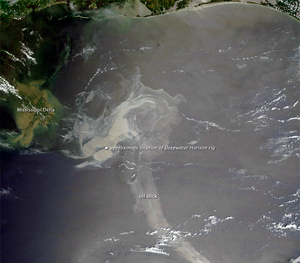|
Gulf of MexicoClick to enlarge A view from space of the Gulf of Mexico on May 19, 2010, showing the spreading oil slick from the Deepwater Horizon beginning to be entrained into the Gulf Loop Current. (Courtesy of NASA) If there is any lesson to take from the Gulf of Mexico it’s that even someplace as close to shore and as relatively well studied as this can still offer some surprises. The Gulf is easy for scientists to get to, but still very complex. Everything from the biology and biodiversity of the Gulf to its underwater geology to the chemistry of the water and the ocean bottom sediments interacts in surprising ways. In addition, it is almost completely surrounded by the United States and Mexico and receives water from one of the longest river systems in the world (the Mississippi River), which means that what happens on land also has a direct impact on the Gulf. Of course, it was made even more complex when nearly 200 million gallons of oil gushed into the water over the course of 86 days during the spring and summer of 2010. Understanding the impact all that oil is having will take a long time to sort out and will require the attention of many scientists and engineers with a wide range of specialties. For now, let’s look at how the biology, geology, and chemistry of the Gulf come together to support some special organisms and ecosystems. Formation of the Gulf About 150 million years ago, the Gulf was a shallow sea that periodically dried up, leaving behind layer upon layer of salt. That shallow sea gradually deepened and a thick layer of sandy, dead plankton, and other organic matter gradually built up on the bottom. Over time and under intense heat and pressure, that material slowly changed into the oil and gas we use today to fill our gas tanks. Back on land, between 80 and 55 million years ago, the Rocky Mountains were formed during a period of mountain building in western North America. From that period until today, erosion has caused large amounts of sediment to wash down the Mississippi River and into the Gulf of Mexico. The weight and density of those sediments piling up on the continental shelf caused the salt layer to move and deform like plastic. In some places, ripples and waves in the salt fractured the rock above, allowing oil and gas to slowly seep up to the sea floor and through the muddy bottom of the Gulf. Oil and Life Many organisms thrive in these places, despite the harsh conditions. The first to appear at a cold seep are microbes. Some microorganisms have the ability to consume substances that are poisonous to animals. At cold seeps, microbes use energy from hydrogen sulfide or methane to form thick mats that attract grazers such as snails and shrimps. Large beds of mussels, which also live on methane, arrive and form habitat with lots of places for smaller animals to live and hide from predators. Many of the microbes also create a hard substance called calcium carbonate that over time builds up on the ocean floor. This is important because much of the bottom of the Gulf of Mexico is sand or mud, so the hard, rocklike carbonates provide a base for the next group of animals to arrive—tubeworms. Tubeworms need a firm foundation in which to sink their root. From this root, they extract chemicals in the ocean floor to feed bacteria that live inside them and that, in turn, provide the tubeworm with food. As the tubeworms grow and expand into dense “forests,” they also provide a complex habitat for other animals to live. Cold seeps can last many centuries, but all of them appear to die out eventually. When the flow of hydrocarbons from the seabed slows and stops, the tubeworms begin to die off. As they do, they open up space for corals to settle and grow on the hard bottom. The corals, which include freestanding soft corals such as fans and sea whips as well as reefs of hard corals, form yet another type of habitat that attracts many other animals, including brittle stars. Humans and the Gulf Despite this, surprisingly little is still known about life on the bottom of the Gulf and how many species rely on both active and former cold seep sites. Even less is known about how animals on the ocean floor might react to any of the thousands of chemicals that make up the oil that spilled. In addition, during the time oil was flowing from the Deepwater Horizon well, thousands of gallons of a chemical known as “dispersants” were pumped into the well, sprayed on the surface of the water, and used to clean equipment. Even less is known how these chemicals might affect life in the ocean.
|
Mailing List | Feedback | Glossary | For Teachers | About Us | Contact
© 2010 Dive and Discover™. Dive and Discover™ is a registered trademark of Woods
Hole Oceanographic Institution

